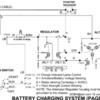I recently got a 100 amp alternator from PI. I installed it with a new external regulator from Checker. Life was good. Lots of amps. Parked it on Monday. Fired it up on Friday to prepare for Autocross this weekend and charging was gone.
I took the alternator and had it bench tested. All OK. Returned and got another regulator. Checked the continuity of the orange and green wires,field and stator. I removed the wires from the connector to tighten them up. I hooked the wires up directly to the regulator. Stared the car. I have constant battery power on the yellow wire. None of the other wires show any voltage using a 12 volt test light or a DVOM. I checked the case ground and it was fine.
Could I have gotten 2 bad voltage regulators?
Original Post



